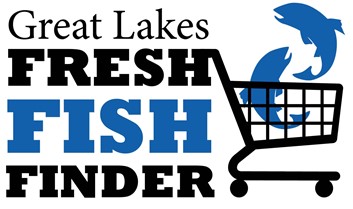Great Lakes Fresh Fish Finder connects consumers with locally produced fish for stocking, bait, fee fishing, ornamentals, and food
Seafood produced in Michigan as well as other states in the Great Lakes region can be easily found online.

Have you been looking to stock fish in your pond? Do you want to eat local seafood? A new tool on the Great Lakes FreshFishFinder.org website features businesses where consumers can buy locally produced fish in the Great Lakes region. Both aquaculture (farm-raised), and commercial fishing (wild-caught) seafood produced right here in Michigan as well as other states in the Great Lakes region can be easily found online.
A partnership between the Great Lakes’ Sea Grant programs including Illinois-Indiana, Michigan, Minnesota, Ohio, New York, Vermont/Lake Champlain, and Wisconsin worked to develop this new tool. Each featured business on the site may include a list of the types of fish sold, whether sales are online and/or in-person, retail outlets that sell their products, a short description about their business, and a link to their website.
Do you want to take the kids fishing, but don’t own the gear? Products featured include not only wild-caught and/or farmed fish or shellfish to eat, but also locations where you can go fee-fishing (or pay pond for recreational fishing), buy fish for stocking public/private ponds or to use as bait, and even for ornamental (e.g., garden ponds, aquariums, etc.) purposes. 
Connecting with local fish producers
Many circumstances during 2020 impacted the fish producing and supply chain industries as the pandemic caused a rapid shift from wholesale to retail markets. During the pandemic, uncertainty within food service establishments (restaurants, institutions, etc), disruptions in the food supply chains, and state policies pertaining to travel caused fish producers to have to switch their sales. Fishers stated that consumer patterns went from their typical sales of 80% wholesale and 20% retail and flipped to 80% retail and 20% wholesale. To help address challenges from the ongoing pandemic in early 2020, Michigan Sea Grant applied for and received a $100,000 COVID-19 rapid response grant from the National Sea Grant Office. These funds aimed to help assess and support the aquaculture, commercial fishing, and charter fishing industries in Michigan in response to 2020 impacts. A portion of these funds were allocated to connect Great Lakes fish producers directly with consumers through various partnerships including the Sea Grant Great Lakes Aquaculture Collaborative. The goal of this partnership is to help create a more sustainable and local Michigan fisheries system that can be resilient as markets change.
Michigan Sea Grant cataloged the 2020 Status of the Industry for both Michigan aquaculture and Michigan’s commercial fishing and fish processing which informed the development of tools and resources such as farm stress teletherapy, Taste the Local Difference, and this website - Fresh Fish Finder. These tools will help foster the development and growth of future, long-term direct-to-consumer markets for Great Lakes fish and aquaculture producers. Diversification of markets will also improve and sustain our local producers' resilience to future market challenges.
Are you a fish producer?
If you are a Michigan fish producer and are interested in having your business listed, please contact Dr. Lauren Jescovitch, Extension educator at 906-487-2974 or jescovit@msu.edu. Non-Michigan producers will need to contact their state Sea Grant program person listed on the site’s about page. The contact person for each state’s Sea Grant program will be responsible to review and update the business listed for their state.
Michigan Sea Grant helps to foster economic growth and protect Michigan’s coastal, Great Lakes resources through education, research, and outreach. A collaborative effort of the University of Michigan and Michigan State University and its MSU Extension, Michigan Sea Grant is part of the NOAA-National Sea Grant network of 34 university-based programs.
This article was prepared by Extension educator Lauren N. Jescovitch under award NA18OAR4170102 (IRB STUDY00004642) from the National Oceanic and Atmospheric Administration, U.S. Department of Commerce through the Regents of the University of Michigan. The statements, findings, conclusions, and recommendations are those of the author(s) and do not necessarily reflect the views of the National Oceanic and Atmospheric Administration, the Department of Commerce, or the Regents of the University of Michigan.



 Print
Print Email
Email

